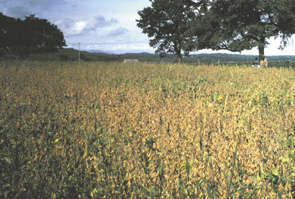September 2003
Soybean rust, the dreaded soybean plant disease that first
appeared in Brazil in 2001, is moving north. Through
checkoff-funded diagnostic tools and research, U.S. soybean
farmers hope to bust rust and protect the U.S. soybean crop.
The United Soybean
Board (USB) hosted a symposium on the disease this
summer at the American Phytopathological Society (APS)
meeting in Charlotte, N.C. The goal of the symposium was to
provide an update on current soybean rust research and
educate other plant scientists on the disease.
“It’s
not a question of if this disease will enter the United
States, but when,” said USB Production Chair Bryan Hieser, a
soybean farmer from Minier, Illinois.
Hieser
said that soybean rust is a fungus that spreads by spores
that move through the air. The disease originated in Asia
and Australia. In 2001, rust was identified in the Western
Hemisphere, in Brazil and Paraguay. Last year, the disease
was identified further north in the Motto Grosso region of
Brazil. |
 |
|
Soybean fields infected with rust may appear
yellow, as evident in this picture of a heavily infected
field in Zimbabwe. |
“Through
our checkoff, U.S. soybean farmers are taking a proactive
approach to fighting this disease,” said Hieser. “USB first
approved soybean checkoff funding for rust research over a year
ago, in December 2001.”
The
checkoff-funded research includes screening of existing
varieties and exotic germplasm to find sources of rust
resistance, identifying management recommendations for
controlling the disease when it enters the United States and the
use of weather models to help predict the spread of rust.
“We have
already screened close to 3,600 lines for rust resistance in a
two-stage process. Of those, 79 lines appear to have some
tolerance to the disease,” said Reid Frederick, Ph.D.,
coordinator of the checkoff-funded rust research underway at the
U.S. Department of Agriculture’s Agricultural Research Service
(USDA-ARS) Foreign Disease-Weed Science Research Unit (FDWSRU)
in Ft. Detrick, Md. The varieties are screened for resistance in
the special Biosafety Level 3 containment facilities at the
FDWSRU in Ft. Detrick.
“We have
also planted U.S. varieties in rust-infected counties and are
collaborating with scientists in those countries who are
conducting tests for the disease,” said Frederick. “In addition
to soybean checkoff funds, we have also received over $1 million
in funds from ARS to sequence the two rust pathogens. And the
Department of Energy is matching those funds.”
In May of
2002, the soybean checkoff was responsible for organizing a
critical meeting that brought together soybean rust researchers,
like Dr. Frederick, with representatives from the USDA’s Animal
and Plant Health Inspection Service, the Cooperative State
Research, Education and Extension Service, and the American
Soybean Association to decide on the role each of these
organizations would take to prepare the United States for
soybean rust.
“Shortly
after that meeting, USB and the soybean checkoff developed
diagnostic guides for soybean rust that were distributed to
farmers, crop consultants, county and university extension
agents, plant pathologists and others,” said Hieser.
The
checkoff-funded rust diagnostic guide and the U.S. Soybean
Diagnostic Guide, which includes information on rust, are both
available online at www.unitedsoybean.org. To order a
printed version of these guides contact Osborn & Barr
Communications at (888) 235-4332.
Farmers who
think they see symptoms of soybean rust in their fields are
encouraged to contact their local county extension agent or
university plant disease diagnostic center immediately.
from
Production Quarterly
The United Soybean Board
Copyright
2003 The United Soybean
Board |